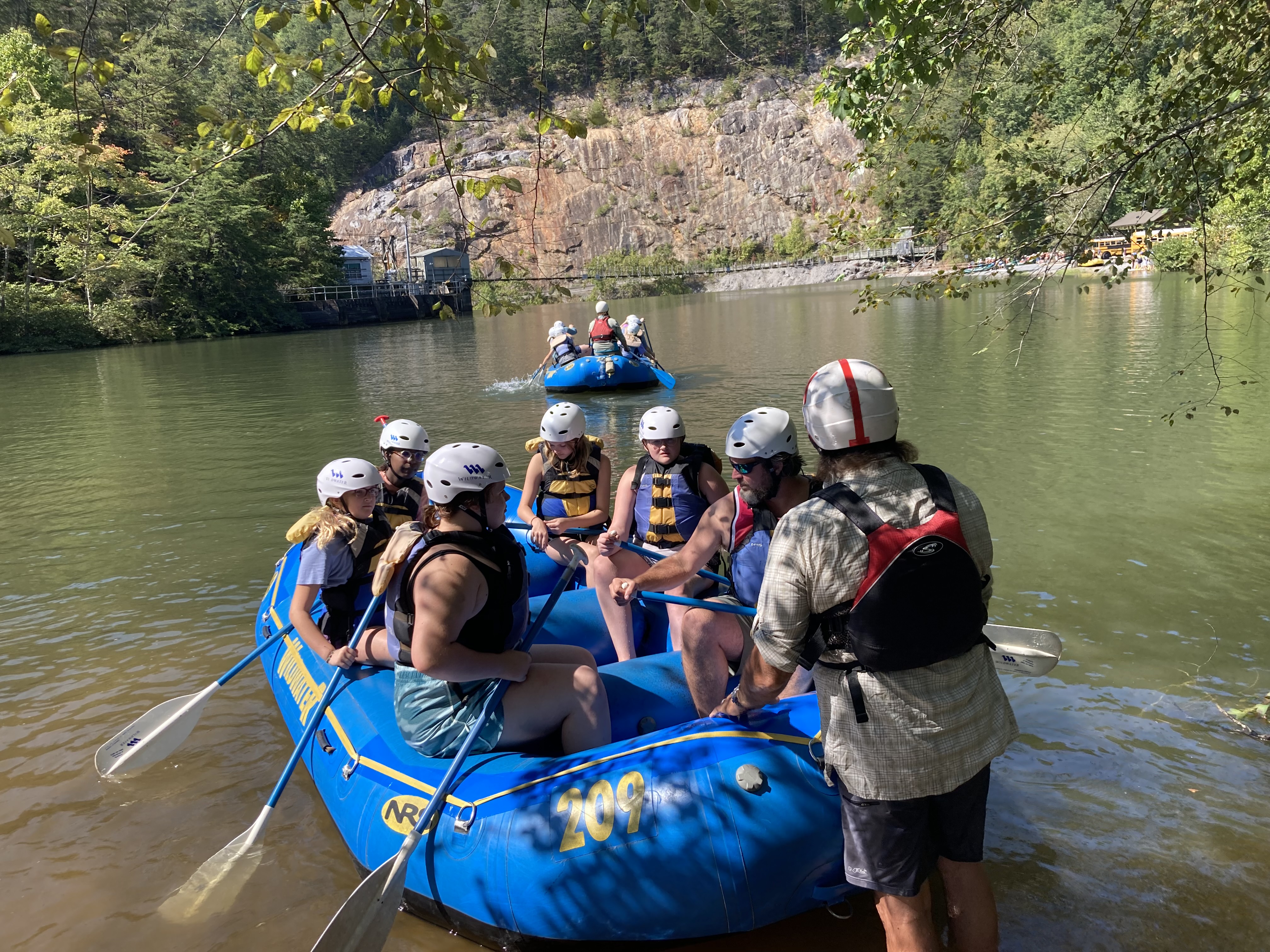News (809)
Children categories
ES! Initiatives (74)
EarthSolidarity!™ Initiatives are endeavors to which anyone can contribute in deed as well as in spirit, that
- minimize waste and environmental impacts
- increase community resilience
- respect and protect ecosystem processes and all forms of life
- contribute to good living conditions for everyone around the globe
- affirm and celebrate our interdependence and interrelatedness in the Web of Life!
Appalachian State Energy Center is crushing it with biochar
Written by Hei-Young Kim Community biochar production in Boone. Appalachian State Energy Center
Community biochar production in Boone. Appalachian State Energy Center
Appalachian State University research helps farmers and crop yield
This article was provided by Appalachian State University. Hei-Young Kim is laboratory manager and research assistant with the Appalachian Energy Center.
BOONE — The Appalachian State Nexus Project experiments continue to advance agricultural innovations with biochar to help local farmers. Biochar is a charcoal-like material produced from plant material such as grass, agricultural and forest residues that produce carbon-rich material used for agriculture and horticulture purposes.
Adding biochar to soil increases surface area, pH, plant nutrient availability, and enhances water-holding capacity, according to Appalachian State researchers. It also can sequester carbon in the ground for extended periods of time, which may otherwise find its way into the atmosphere as CO2 or methane.
The qualities of biochar vary depending upon the material it comes from — timber slash, corn stalks or manure.
 “Ring of Fire” annular eclipse. NASA
“Ring of Fire” annular eclipse. NASA
While most people associate “Ring of Fire” with the great Southern country singer Johnny Cash, it will feature a different beat on Oct. 14 when the “Ring of Fire” annular eclipse will cross North, Central and South America.
 For other locations and more details visit Time and Date.
For other locations and more details visit Time and Date.
The moon will pass in front of the sun, and an annular eclipse will be visible over much of the United States and Central and South America. Unlike a total solar eclipse, the moon will not completely block the sun and make day appear like night. It will, however, make the sun appear like a thin ring of fire. The difference between an annular and a total eclipse is that the moon’s orbit varies slightly in it’s distance from Earth. If an eclipse occurs when the moon is at a farther point during its orbit, it will appear slightly smaller and not large enough to cover the sun completely.
All eclipse-watchers on Oct. 14 will need to use special eye protection — such as eclipse glasses or a specialized solar filter — or an indirect viewing method to safely watch. Such safety measures must be used throughout the entire eclipse, no matter a viewer’s location, as even the small ring of sun visible at the peak of the annular eclipse is dangerous if viewed directly.
Live coverage of the eclipse will air on NASA TV and the agency’s website from 11:30 a.m. to 1:15 p.m. Oct. 14 The public may also watch live on social media accounts on Facebook, X, and YouTube.
 Launching a raft for the rapids on the Ocoee River to raise awareness for TennGreen’s effort to acquire land along Clear Creek in Morgan County. Ben Pounds/Hellbender Press
Launching a raft for the rapids on the Ocoee River to raise awareness for TennGreen’s effort to acquire land along Clear Creek in Morgan County. Ben Pounds/Hellbender Press
A raft trip on the Ocoee helped save faraway Clear Creek
DUCKTOWN — We threw our backs into paddling as the raft dipped and crested.
We were on the Ocoee River in southeastern Tennessee, but Clear Creek, 118 miles away in Morgan County, was the reason for the occasion.
I joined the group, some of whom were staying in nearby cabins overnight, for rafting and a cookout.
It was part of a TennGreen push to buy and preserve 180 acres of land along Clear Creek. It will then sell 23 of those acres, which includes a house. It will donate the rest to the Obed Wild and Scenic River, an adjoining federal conservation area.
Cool water deluged us, rapid after rapid. In one case we spun with momentum. We high-fived with our paddles when we hit clear spots after a successful run.
That evening, we unwound with hot dogs, burgers both vegetarian and meat, potato salad and s’mores among other treats at the Cabins at Copperhill.
TennGreen Deputy director Christie Henderson said buying the Clear Creek land would allow for a connected wilderness area in which plants and animals could have a safe corridor. It also would preserve the view of the night sky from potential light from new houses.
Cumberland Trails summit coming in October

The Cumberland Trail Summit is happening October 19-21, 2023. The Cumberland Trail Summit is an opportunity to showcase our trail communities. The Summit will focus on outdoor recreation, community building and educational programs
The mission of the Cumberland Trails Conference is to provide paid and volunteer labor, equipment, supplies and vehicles to design and construct the Cumberland Trail under the auspices of the Tennessee Department of Environment and Conservation.
The continued development and construction of the Cumberland Trail is accomplished through a working relationship between the Cumberland Trails Conference (CTC), the Cumberland Trail State Scenic Park, and the Tennessee Department of Environment and Conservation. The CTC, private corporations, foundations, individuals and others assist TDEC in raising funds for land acquisition, providing maintenance and further developing the Cumberland Trail.
The Cumberland Trail State Scenic Trail State Park operates a professional trail crew mostly in the north sections.
The Cumberland Trails Conference also maintains a professional trail crew that works twelve months a year. Additional labor comes from thousands of hours of volunteer service provided through the CTC, including through the CTC BreakAway, a college Alternative Spring Break program.
The Cumberland Trail is an extensive foot trail constructed and maintained largely by volunteers from Tennessee and across the nation. The Trail is managed by the Tennessee Department of Environment and Conservation (TDEC).
Building the Cumberland Trail is a grassroots effort, driven by communities along the trail, government agencies and a broad network of volunteers. This successful private/public partnership is a model often cited to demonstrate the power of volunteerism and public/private partnerships.
When completed, the Cumberland Trail will extend more than 300 miles from its northern terminus in Cumberland Gap National Historical Park in Kentucky to its southern terminus at the Chickamauga-Chattanooga National Military Park located on Signal Mountain just outside Chattanooga, Tennessee.
— Cumberland Trails Conference

Traditional downtowns are dead or dying in many US cities
Written by John Rennie Short
Lunch atop a skyscraper, first published in the New York Herald-Tribune, Oct. 2 1932. Charles Clyde Ebbets
‘All that is solid melts into air’
John Rennie Short is professor emeritus of public policy at the University of Maryland. This article was originally published in The Conversation.
The hollowing out of U.S. cities’ office and commercial cores is a national trend with consequences for millions of Americans. As more people have stayed home following the COVID-19 pandemic, foot traffic has fallen and major retail chains are closing stores, and prestigious properties are having a hard time retaining tenants.
(Some Southeastern cities, like Knoxville, Asheville and Greenville have seen the opposite occur).
In May 2023 the shuttering of a Whole Foods market in downtown San Francisco received widespread coverage. Even more telling was the high-end department store Nordstrom’s decision to close its flagship store there in August after a 35-year run.
In New York City, office vacancy rates have risen by over 70% since 2019. By spring of 2023 Chicago’s Magnificent Mile, a stretch of high-end shops and restaurants, had a 26% vacancy rate.
A recent study from the University of Toronto found across North America, downtowns are recovering from the pandemic more slowly than other urban areas and “older, denser downtowns reliant on professional or tech workers and located within large metros” are struggling the hardest.
Like many U.S. cities, Portland, Oregon, is losing downtown businesses. This cuts into urban revenues and creates a perception of decline.
Over more than 50 years of researching urban policy, U.S. cities have weathered through many booms and busts. Now there is a more fundamental shift taking place. Traditional downtowns are dying or on life support across the U.S. and elsewhere. Local governments and urban residents urgently need to consider what the post-pandemic city will look like.
- whole foods
- john rennie short
- chicago’s magnificent mile
- university of toronto
- university of maryland
- nordstrom
- portland, oregon
- repurposing office space
- biotech labs
- the conversation
- hollowing out of city
- retail chain
- postpandemic retail
- store closing
- downtown retail
- urban policy
- excess commercial space
- vacant office space
- tax revenue
- zoom town
- ridership decline
- public transportation
- abandoned mall
- zoning law
- urban property market
- telecommute
- virtual meeting
Public Lands Day looking for volunteers
Big South Fork celebrates National Public Lands Day 2023 on Saturday, September 23 with a Volunteer Trails Event
ONEIDA — Take part in the National Public Lands Day celebration at the Big South Fork National River and Recreation Area.
On this day, the park is looking for volunteers to help build out the last section of the Sheltowee Trace National Recreation Trail.
Interested volunteers should meet at the R.M. Brooks General Store (2830 Rugby Parkway, Robbins TN 37852) on Saturday the 23rd at 8:30 a.m. Eastern Time. Please wear long pants and sturdy footwear.
Established in 1994 and held annually on the fourth Saturday in September, National Public Lands Day celebrates the connection between people and green space in their community, inspires environmental stewardship and encourages use of open space for education, recreation and health benefits.
For more information visit the Big South Fork National River and Recreation Area website or call 423-569-9778.
Oak Ridge research suggests rough weather ahead
OAK RIDGE — Researchers from Oak Ridge National Laboratory and Northeastern University modeled how extreme conditions in a changing climate affect the land’s ability to absorb atmospheric carbon — a key process for mitigating human-caused emissions. They found that 88 percent of Earth’s regions could become carbon emitters by the end of the 21st century.
Climate extremes lasting months or years could reduce plant productivity, which governs Earth’s capacity to produce food, fiber and fuel. Events such as wildfires could generate bursts of emissions from carbon stored in forests.
The team used the open-source Community Earth System Model to simulate multiple variables, which enabled a holistic understanding of how climatic conditions interact.
“Our results suggest that meteorological extremes will become more frequent, intense and widespread due to the compound effect of high temperature, drought and fire,” said ORNL’s Bharat Sharma. “Tropical regions may face these to the most extreme degree.”
Public can learn more about distilled Knox Urban Forest Master Plan Sept. 13

KNOXVILLE — Trees Knoxville and the city will update citizens on progress on the Urban Forest Master Plan. Trees Knoxville, an organization dedicated to preserve and increase the urban tree canopy on private and public lands in Knoxville and Knox County, will host an open house from 5:30-7 p.m. Sept. 13, at the Public Works Service Center (3131 Morris Ave.) to discuss the latest Urban Forest Master Plan.
Trees Knoxville and city urban forester Kasey Krouse will share recommendations from Urban Canopy Works LLC based on public input.
“We have taken everything we’ve learned over the last year and developed draft goals, as well as strategies and action steps to meet those goals,” Trees Knoxville Steering Committee said in a release. “While the plan is not yet fully developed, we would like to update the community on the direction the plan is headed, providing an opportunity to give feedback before the final draft is produced.”
This forum will update the planning process Trees Knoxville and city staff have been working on with a consultant from Urban Canopy to learn about the public thoughts, opinions and goals for the city’s urban canopy — tree cover in public places and on private property.
The hope is a successful forest plan will help the city preserve, grow and care for trees, which play a significant role in public and environmental health.
Appalachian trout in trouble as temps rise, storms rage
Written by Dan Chapman Michael Bradley, a fly-fishing guide, on Raven Fork in the Oconaluftee area of the Great Smoky Mountains. U.S. Fish and Wildlife Service
Michael Bradley, a fly-fishing guide, on Raven Fork in the Oconaluftee area of the Great Smoky Mountains. U.S. Fish and Wildlife Service
Climate change could steal your fish
Dan Chapman is a public affairs specialist for the Southeast Region of U.S. Fish and Wildlife Service.
CHEROKEE — The mountains of the Southern Appalachians were scraped clean a century ago. Headwater ecology changed as the canopy of trees disappeared that was shading the streams from all but the noonday sun. Rainstorms pushed dirt and rocks into the water muddying the feeding and breeding grounds of fish, amphibians and insects.
Lower down the mountain, newly cut pastures edged right up to the creeks while cows mucked up the once-pristine waters. Invasive bugs killed hemlocks, ash and other shade-giving trees. Pipes, culverts and dams blockaded streams and kept animals from cooler water.
The trout never had a chance.
Now they face an even more insidious foe — climate change.
- doug reed
- chattahoochee national forest
- trout season
- trout unlimited
- nc institute for climate science
- mike lavoie
- wild brook trout
- fly fishing team
- oconaluftee river
- raven fork
- ela dam
- toccoa river
- trout fishing in the southern appalachians
- dan chapman
- eastern band of cherokee indians
- eastern brook trout
- trout fishing
- qualla boundary
- brown trout
- rainbow trout
- north carolina state university
- chattahoochee river
- rough branch
- dissolved oxygen
- climate change
- headwater
- fish biodiversity
- fish stock
- fishing
- fish hatchery
- drought
- hemlock woolly adelgid
- sedimentation
- coldwater fishery
- fish disease
Public meeting about solutions to remove solid waste in downtown Knoxville is set for Sept.14
KNOXVILLE — On Thursday, Sept. 14, the city, MSW Consultants and DSM Environmental will present findings from the 2023 Downtown Solid Waste Study. The meeting will take place at 5:30 p.m. at Lox Salon, 103 W. Jackson Avenue.
Members of the public are welcome to attend and learn about how downtown solid waste and recycling is currently being collected, costs involved, and a look at future collection options.
The Downtown Solid Waste Study was launched to address concerns about downtown growth and increased solid waste production. The city currently spends more than $550,000 each year for downtown trash and recycling services.
— City of Knoxville
Guided Bird Walk with Dr. Chuck Nicholson, September 16 at Big South Fork

ONEIDA — September 16, 2023 at 8:00 AM (ET), don’t miss the unique opportunity to explore the lush landscapes of the Cumberland Plateau in Tennessee, guided by Dr. Charles Nicholson. The walk will begin at the Bandy Creek swimming pool at Big South Fork National River and Recreation Area and promises to be an easy, enjoyable experience for all ages.
Dr. Nicholson is not just an experienced birder; he’s an authority on the subject with over 35 years of specialized experience in the Big South Fork area. A committed member of the Tennessee Ornithological Society, Dr. Nicholson has served multiple roles within the organization, including president and journal editor.
Dr. Nicholson holds a PhD in Ecology and Evolutionary Biology with a focus on birds. He is the author of the Atlas of Breeding Birds of Tennessee, a seminal sourcebook for bird enthusiasts, and served as adjunct professor at the University of Tennessee. Dr. Nicholson has led numerous birding field trips and even offers a course on birdwatching.
This bird walk serves as the perfect prelude to the 31st Annual Haunting in the Hills Storytelling Festival, inviting everyone to connect with nature before diving into the rich tapestry of stories that the festival has to offer.
For more information about this special event as well as other events, call 423-569-9778, or visit online: www.nps.gov/biso.
Former Tennessee Wildlife and Resources Agency biologist alleges agency manipulated data on deer disease
Written by Anita Wadhwani A Tennessee deer with Chronic Wasting Disease. Tennessee Wildlife Federation
A Tennessee deer with Chronic Wasting Disease. Tennessee Wildlife Federation
In a lawsuit filed against the agency, the former employee claims officials misled the public about the rate of a neurological disorder in deer, changing protocols to avoid admitting mistakes.
This story was originally published by Tennessee Lookout.
NASHVILLE — A former state biologist claims he was confronted in his home by law enforcement officers with the Tennessee Wildlife Resources Agency on the same day he sent his boss’s superiors evidence the state was falsifying data on wildlife diseases.
After his cell phone, laptops and other items were confiscated, the biologist said he was then subjected to hours of questioning by officers — among them the husband of his immediate supervisor.
James Kelly (video link features Kelly at 10 minutes), a wildlife biologist, led the Tennessee Wildlife Resources Agency’s deer management program, chaired the agency’s Chronic Wasting Disease (CWD) Deer Management Standing Team and served as a wildlife biologist until he was fired in 2022.
In a whistleblower lawsuit filed this week, Kelly alleges state officials manipulated data and misled the public about the prevalence of chronic wasting disease, a fatal and infectious disease that attacks deer populations.
(TWRA would not comment on the specific allegations in the filing, but said its data was solid).
Inflation Reduction Act charges positive clean-energy results in Southeast
 Electric car recharging. Courtesy Wikipedia Commons
Electric car recharging. Courtesy Wikipedia Commons
KNOXVILLE — This month marks the one-year anniversary of the Inflation Reduction Act, the most significant clean energy and climate action legislation in U.S. history, and our region is already seeing massive economic benefits. Consider this: just one year into the Inflation Reduction Act (IRA), four Southeastern states rank in the top 10 nationally for new clean energy investments:
- Georgia: $18.83 billion with 22 new major clean energy projects, the 2nd most in the nation
- South Carolina: $11.71 billion with 20 new major clean energy projects,
the 3rd most in the nation - Tennessee: $5.76 billion with 13 new major clean energy projects, the 6th most in the nation
- North Carolina: $9.61 billion with 9 new major clean energy projects, the 10th most in the nation
- Florida: $503 million with 5 new major clean energy projects
The Southeast will also be a leading hub for electric vehicle (EV) manufacturing with more than 60,000 announced jobs, according to SACE's fourth annual Transportation Electrification in the Southeast report, produced with Atlas Public Policy, which will be published next Wednesday, September 6. The report also shows that Georgia leads all states in the country for announced EV manufacturing jobs. Join us for the webinar on September 6 at 11:00 a.m. ET to hear more highlights of the report.
While the economic growth numbers from the first year of the IRA are encouraging, the real impacts will be measured by the people and communities that will benefit from the transition to clean energy.
— Southern Alliance for Clean Energy
SELC settlement protects blue-blood horseshoe crabs and their avian dependents
 Red Knot.
Red Knot. Chuck Homler
CHARLESTON — A landmark settlement prohibits horseshoe crab collection on the beaches of more than 30 islands along the South Carolina coast that are established feeding sites for rufa red knots during their annual migration — as well as any harvesting in Cape Romain National Wildlife Refuge — for at least five years.
Every spring, red knots time their 9,300-mile migration from South America to the Canadian Arctic perfectly so they stop on the same beaches of South Carolina at the exact moment horseshoe crabs begin to spawn.
These protein-rich crab eggs are critical for red knots, providing the fuel they need to complete their transpolar journey. This delicate relationship between horseshoe crabs and red knots has developed over millions of years.
Butterfly release scratched at UT Arboretum festival after pushback on ecological wisdom
Written by Thomas Fraser Come join the fun at the annual UT Arboretum Society Butterfly Festival from 10 a.m to 1 p.m on September 9 at the UT Forest Resources AgResearch and Education Center and Arboretum. The event will include educational activities about protecting these pollinators. Photo courtesy University of Tennessee Institute of Agriculture
Come join the fun at the annual UT Arboretum Society Butterfly Festival from 10 a.m to 1 p.m on September 9 at the UT Forest Resources AgResearch and Education Center and Arboretum. The event will include educational activities about protecting these pollinators. Photo courtesy University of Tennessee Institute of Agriculture
UT grounds planned butterfly release but festival will fly
OAK RIDGE — The University of Tennessee Arboretum canceled a planned release of painted butterflies originally scheduled for its upcoming annual butterfly festival, but the pollinator-positive educational event will go on to the joy of families and nature enthusiasts across East Tennessee.
“While the fun-filled and educational event is still scheduled for Sept. 9, a mass release of painted lady butterflies is no longer scheduled as part of the event,” according to the UT Arboretum Society.
The 8th annual festival will occur from 10 a.m. to 1 p.m. at the UT Forest Resources AgResearch and Education Center and Arboretum, 901 S. Illinois Avenue, Oak Ridge. Plenty of activities will provide educational opportunities for the public to learn how we can all protect our pollinators, according to the UT Institute of Agriculture.
“The butterfly species previously planned for release at the festival was the painted lady, Vanessa carduii. Butterfly releases have been held at past festivals with the intention that the more people understand an organism, the more they are inspired to help protect it. Though there has not been definitive scientific research about the impact of painted lady butterfly releases, the UT Arboretum Society has decided to join many other scientific organizations, such as the North American Butterfly Association and the Smithsonian Institute, in not promoting this practice,” according to a release.
- ut arboretum
- tennessee naturscapes
- north american butterfly association
- ut arboretum society
- butterfly festival
- painted butterfly
- ut institute of agriculture
- oak ridge arboretum
- butterfly
- ut butterfly festival
- butterfly release bad
- nature for kids
- things to do around knoxville september 9
- teach kids about nature knoxville
- vanessa carduii
- donna edwards
- stephen lyn bales
- laura russo
More...
 Jimmy Groton, a Tennessee Citizens for Wilderness Planning board member, clears invasive plants at Worthington Cemetery in Oak Ridge during a volunteer work party in July. Ben Pounds/Hellbender Press
Jimmy Groton, a Tennessee Citizens for Wilderness Planning board member, clears invasive plants at Worthington Cemetery in Oak Ridge during a volunteer work party in July. Ben Pounds/Hellbender Press
Volunteers nurture life in an Oak Ridge cemetery
OAK RIDGE — The northern corner here is a small place teeming with treasures, including the Worthington Cemetery Ecological Study Area.
Elza Gate Park off Oak Ridge Turnpike, also known as Tennessee Highway 95, is the starting point for walking trails taking visitors through a cedar barren, a somewhat open habitat including eastern red cedars. The barrens include plants more similar to a prairie than many East Tennessee forests. The trail reaches a cemetery dating before the founding of Oak Ridge.
Woven together in this small area there is a natural mix of wildlife and historical preservation. Visitors to the loop trail will encounter a pine forest and a wetland area complete with a boardwalk to observe birds. Tennessee Valley Authority designated the land as both an Ecological Study Area and Small Wild Area.
- elza gate park
- oak ridge
- tennessee valley authority
- samuel worthington
- global ecology and conservation
- tennessee citizens for wilderness planning
- jimmy groton
- melton hill lake
- nature conservancy
- worthington cemetery ecological study area
- tva oak ridge
- twra
- red cedar barren
- tennessee prairie
- invasive plant control
- exotic species
- ann hewitt worthington
- citizen pest plant control
 Cynthia Maples, the head beekeeper at Zoo Knoxville, checks out her buzzing charges. JJ Stambaugh
Cynthia Maples, the head beekeeper at Zoo Knoxville, checks out her buzzing charges. JJ Stambaugh
With no clear cause, after two decades beekeepers across North America report losing up to 90 percent of their hives.
Although the alarming losses of the 2006-7 season have not repeated, since then, experts consistently track higher than normal winter losses among honeybee colonies, according to the U.S. Environmental Protection Agency (EPA).
A survey by the University of Maryland University of Maryland found 40% of US honeybee colonies died between April 2018 and April 2019.
While most Americans associate the insects with one of humankind’s oldest sweet treats - honey - they might not realize honeybees are actually an invasive species that can end up competing for resources with indigenous “pollinators” such as bumblebees.
“Worldwide, there are over 20,000 species of bees,” said Cynthia Maples, the lead beekeeper and apiarist at Zoo Knoxville. “About 265 of those are bumble bees. In North America, there are 46 bumblebee species. In the southeast, we have about 15 bumble species with at least six of those in decline.”
Maples explained all bees are part of the order Hymenoptera, which also includes ants and wasps.
“Native pollinators would classify as those species naturally occurring in a particular area, not introduced. Honeybees are technically an invasive species to North America. They were brought over from Europe by humans,” she said.
“In the past few years the narrative has made a switch from keeping honeybees to help native pollinators to the realization that honeybees may be stealing resources from native pollinators,” she continued. “Honeybees are still very important as agricultural pollinators, but protecting native pollinators is also very important.”
While Maples doesn’t know if local bee populations are on the ropes, she said the Xerces Society for Invertebrate Conservation (an international nonprofit group) has formed regional “community science groups” as part of a widespread effort to track bumblebee species.
“It’s really hard to say specifically if there has been a decline in local insect populations since insects are very difficult to track,” she said. “I took part in the training for the southeast bumble bee atlas earlier this year. The hope is that this atlas will give scientists a better idea of population numbers.”
It’s important that scientists understand any threats to the health of the world’s bee populations as the insects are vital to humankind’s ability to survive.
Bees — both domesticated and wild — are responsible for pollinating 71 of the 100 crop species that provide 90 percent of the global food supply, according to experts from greentumble.
Without bees, for instance, there would be no apples, avocados, onions, cucumbers, oranges or almonds.
“Pollination is defined as the act of transferring pollen grains from the male anther of a flower to the female stigma,” Maples explained. “When bees go from flower to flower collecting pollen, they are also depositing pollen grains onto the flowers, thus pollinating them. Not all plants rely on insects to reproduce; for example, some are wind pollinated.”
“The bees benefit because nectar and pollen are their food source. Nectar is an energy source and pollen is a protein source for them. Many agricultural plants are pollinated by bees, hence their importance for us. Roughly one in three bites of food are pollinated by bees, plus another 25 percent of animal feed stuffs. Almonds are 100 percent honeybee pollinated.”
It’s not entirely clear why bee populations appear to be shrinking, but Maples said there’s no shortage of possible explanations.
“As with many species in decline, there are a number of reasons behind it,” she said. “Habitat loss is a big one. Our culture has taught us that we should have pristine lawns without ‘weeds,’ but letting your yard — even in part — grow wild would be a huge step in creating more resources for pollinators. Dandelions and clover can be a haven for pollinators.”
Poisons used to control unwanted animals and insects are another factor.
“Pesticides have a huge impact as well, especially though containing neonicotinoids,” she said. “Pesticides rarely distinguish between beneficial invertebrates and those that cause harm.”
This summer’s historic heatwaves in the Northern Hemisphere may also be playing a role, but Maples cautioned that it’s too early to know for certain what the impact is.
“Climate change may also be playing a role,” she explained. “It isn’t clear if bumblebees are adapting to changing temperatures within their normal ranges.”
Those interested in helping researchers to track bee populations can go to Xerces and learn about taking part in one of the organization’s community science groups.
Do bees really have knees? And more on the idiom.
Beginning Farmer Field Day
Beginning Farmer Field Day Teaches New Farmers About Agriculture, Profitability
University of Tennessee and Local Partner Organizations Host Free Regional Event
TRENTON — Tennessee AgrAbility, UT-TSU Extension Gibson County, and various partner organizations hosted Beginning Farmer Field Day on July 20, 2023. This free educational class was open to all West Tennessee farmers with less than 10 years of agricultural experience, providing them with the information and resources needed to become successful long-term producers.
Presentation topics included business planning, agricultural decision making, income management, production strategies and more. Attendees also received a tour of a Gibson County farm where they learned about agriculture conservation practices as well as locally available assistance programs.
The event was led by Gibson County Extension agents along with representatives from various local, state and national organizations including Tennessee AgrAbility, the UT MANAGE program, The STAR Center, Natural Resources Conservation Service (NRCS), Soil and Water Conservation Districts (SWCD), Farm Service Agency (FSA), Center for Profitable Agriculture (CPA) and various independent farmers.
Joetta White, Extension area specialist for AgrAbility in West Tennessee, says she hopes the event will positively impact the future of agriculture by ensuring farmers of all sizes have the resources they need to be successful. “Farming can be a challenging and costly industry to get started in. However, we believe that the best way to become a successful producer in West Tennessee is not to do it alone, but to instead learn from one another and from those who came before us. Beginning Farmer Field Day is about making sure agriculture is accessible for people of all ages, backgrounds and skill levels.”
Jake Mallard, county director of UT-TSU Extension Gibson County, says that countless people every day depend on the work of our local farmers. “Our need for farmers and what they produce cannot be emphasized enough, and programs such as Beginning Farmer Field Day can have a widespread impact on our local community and beyond. Attendees were able to receive the tools and tactics they need to better improve production or begin farming for the first time. I know we will all benefit from their success.”
The field day was made possible thanks to a grant from the Tennessee Department of Agriculture (TDA) as well as through local support from Farm Credit Mid-America and Gibson County Young Farmers & Ranchers. Over 40 local farmers from across West Tennessee attended the event.
Tennessee AgrAbility is a community-based program that assists Tennessee producers who have temporary or permanent disabilities. The program is offered in partnership with University of Tennessee Extension, Tennessee State University Extension, USDA, The STAR Center and Tennessee Technology Access Center. Tennessee AgrAbility educates and assists Tennessee’s farmers, farm workers and their family members that have disabilities so they can increase their independence and productivity. Their mission is to enhance and protect the quality of life and preserve livelihoods for farm families touched by disability.
Through its land-grant mission of research, teaching and extension, the University of Tennessee Institute of Agriculture touches lives and provides Real. Life. Solutions. utia.tennessee.edu.
Virginia Tech sleuths are investigating mysterious hellbender disappearances
Written by Mike Allen Virginia Tech Professor Bill Hopkins preparing to gently return a hellbender to its underwater home in a Virginia stream after taking measurements. Lara Hopkins/Virginia Tech
Virginia Tech Professor Bill Hopkins preparing to gently return a hellbender to its underwater home in a Virginia stream after taking measurements. Lara Hopkins/Virginia Tech
One clue: They eat their own in deforested stream corridors
Mike Allen is a media relations officer for Virginia Tech.
BLACKSBURG — The gigantic salamanders known as hellbenders, once the apex predators of many freshwater streams, have been in decline for decades, their population constantly shrinking. No one knew why. William Hopkins, professor in the Department of Fish and Wildlife Conservation and director of the Global Change Center at Virginia Tech, suspected the hellbenders’ plight had connections with environmental changes engineered by humans.
Hellbender males select nesting sites on stream bottoms and guard the eggs laid there by females — and occasionally the salamander dads snack on the eggs, consuming them before they ever get to hatch. A study that Hopkins led, conducted through eight years of snorkeling in ice-cold Southwest Virginia streams and published in The American Naturalist, determined that in deforested areas, hellbender fathers are far more likely to eat their entire brood than in areas that still have lush foliage.
This behavior, known as filial cannibalism, probably evolved as a survival tactic for enduring harsh conditions. Prior to Hopkins’ results, scientists were not aware that hellbenders’ filial cannibalism drastically increased in cleared lands, actively speeding the species out of existence.

